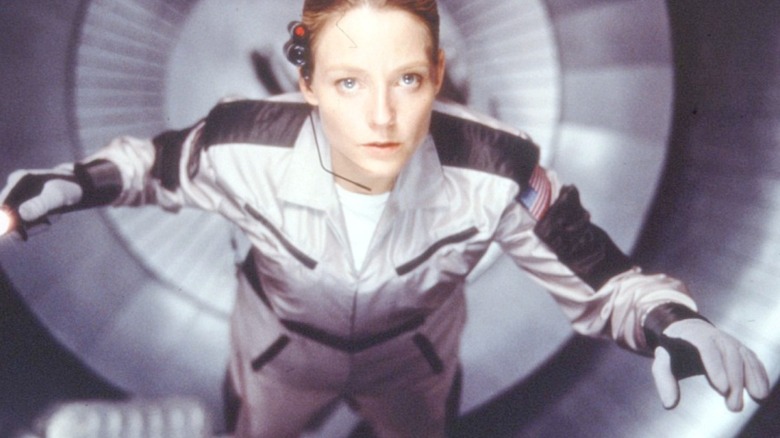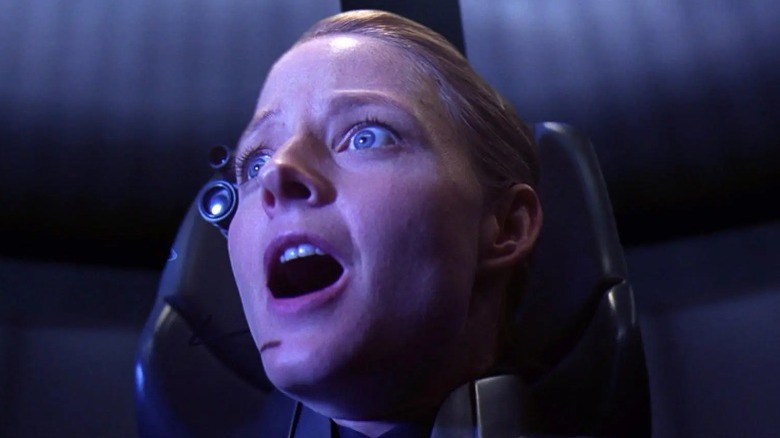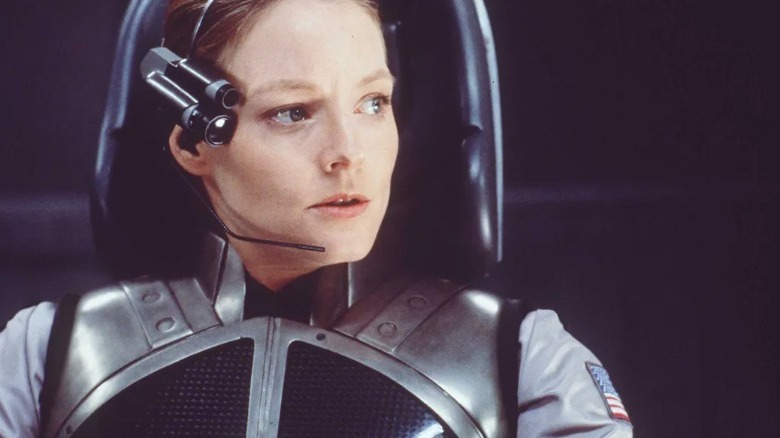On-Set Fires And Jodie Foster's Costume Made Contact's Wormhole Scene A Slog To Film
Robert Zemeckis' "Contact" hit theaters in July 1997 and managed to break the mold of sci-fi drama prevalent during the time. The reasons were manifold. Ann Druyan, who was the creative director at NASA at the time, along with partner and acclaimed astronomer Carl Sagan, envisioned an unconventional tale about a headstrong female scientist on a mission. Moreover, the aliens in "Contact" were not terrifying monsters that needed to be defeated for humans to survive, making it a very different from popular films of the time like "Alien Resurrection," which was also released in 1997.
The premise of "Contact" is simple: A gifted scientist, Ellie Arroway (Jodie Foster), stumbles upon an odd signal sent from a star system named Vega. After years of research and preparation, Ellie is sent on a lone mission to Vega, wherein she makes first contact with aliens. However, Ellie's account of this transcendent experience is rejected by the scientific community, as there is no recorded evidence of this potential breakthrough for humanity, except for Ellie's personal testimony. "Contact" raises questions about science and religion, the belief systems that emerge from both camps, and whether they can coexist in some capacity.
"Contact" suffered from a cursed production process ever since Druyan and Sagan conceptualized the story, and the film had to overcome plenty of obstacles before it saw the light of day. The film's stunning wormhole scene was particularly challenging to pull off for a myriad of reasons. Here's how everything panned out (and worked out) for the scene in question.
An indescribable experience
The wormhole sequence in "Contact" is clearly a standout in the film. Ellie is launched into the unknown alone and loses contact with mission control the moment she travels through a series of wormholes. This experience is unlike anything humanity has ever experienced: After her vessel comes to a standstill, Ellie looks out and witnesses a celestial event. The galaxy is beautiful, and words fail her for the first time. "Poetry! They should have sent a poet," she says — a sublime remark that encapsulates the essential truth of the universe.
Understandably, this scene was extremely difficult to shoot. Foster worked with a blue screen and had to simulate the experience of traveling through wormholes and witnessing both beauty and terror. How does one emote an experience never seen or felt before? While Foster carries the scene with incredible skill and conviction, practical hurdles made the filming process long and tedious. In an article commemorating the 25th anniversary of "Contact," Foster told Vulture about how the set caught on fire during filming:
"My stunt double, Jill, was bolted in. They had to get her out quickly. It was a really gnarly fire, and it went fast, and it burned down one of our stages. It must have been an electrical thing or something."
Zemeckis assured that no one was hurt due to the incident, but they had lost a couple of precious hours. Another hurdle was that Foster had to be shaken violently on the shuttle chair to mimic fast space travel, and she prepared for this part by going on back-to-back Magic Mountain rides. I'm guessing it wasn't very pleasant for her, but not all heroes wear capes.
Capturing the unknowable
Another technical hurdle was Foster's astronomer costume, which was bolted to the shuttle chair for the scene. This made the violent shaking extremely unpleasant for Foster, as there was technically no escape from the "Joan of Arc armor" she had to don. Foster also had to talk/move backward to capture the chaotic, otherworldly nature of the sequence. While going through the motions of reacting to something unknowable, Foster had to repeat the line "I'm okay to go" many times, partly because it is a real phrase used by NASA scientists during missions. However, "Contact" imbues the line with multifaceted meaning. "I'm okay to go" becomes a grounding mantra for Ellie, as it alludes to her willingness to step into the next frontier.
Apart from this, nailing the mechanics was tough for Zemeckis, as the aim was not to replicate a scientifically accurate hypothesis, but to tap into an artistic interpretation of the experience. Zemeckis told Vulture that the wormhole travel mechanics were "completely arbitrary," while Foster affirmed that the scene was about "our own fears and desires" and not meant to be true to life.
The rest of the cast, including David Morse (who played Theodore Arroway) and Matthew McConaughey (who played Palmer Joss), praised Foster's performance in that scene, as her expressions were powerful enough to evoke what we are meant to feel. Morse said:
"I'm pretty sure it took them two weeks to shoot that. I'm always astounded when I look at the scenes because I know she [Foster] was alone. She was having to create for herself all that emotional life."
Undoubtedly, Foster deserves all the praise. Despite the inherent challenges of capturing the absurdity of the scene, "Contact" was able to weave everything together in an intensely poetic fashion. The rest is history.


